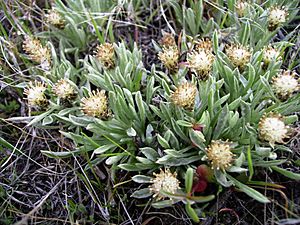Low pussytoes facts for kids
Quick facts for kids Low pussytoes |
|
|---|---|
 |
|
| Antennaria dimorpha near Monitor, Chelan County Washington | |
| Scientific classification | |
| Genus: |
Antennaria
|
| Species: |
dimorpha
|
| Synonyms | |
|
|
Antennaria dimorpha is a small flowering plant found in North America. People often call it low pussytoes or gray cushion pussytoes. It belongs to the daisy family, just like sunflowers and dandelions! This plant grows naturally in western Canada and the western United States. You can find it from British Columbia down to California and New Mexico. It usually likes to grow in dry places.
All About Low Pussytoes
Antennaria dimorpha is a special kind of plant that grows in a flat, mat-like shape. It's a perennial, which means it lives for more than two years. It grows from a thick, branching part called a caudex, which is like a woody base.
What Low Pussytoes Look Like
The leaves of this plant are shaped like small spoons. They are only about one centimeter long. Even though they are green, they are covered in soft, long, gray hairs. This gives the plant a fuzzy, cushion-like look.
The plant's flowers grow on short stems, only a few centimeters tall. Each stem has just one flower head. This head is covered with special leaf-like parts called phyllaries. These phyllaries are often dark brown and green.
How Low Pussytoes Reproduce
Antennaria dimorpha is a dioecious plant. This means that some plants are male and some are female. Male plants have flower heads with only male parts (stamens). Female plants have flower heads with only female parts (pistils).
After the female flowers are pollinated, they produce small fruits. These fruits are called achenes. Each achene has a long, soft, and barbed pappus. This pappus acts like a tiny parachute, helping the seeds float away in the wind to find new places to grow.

